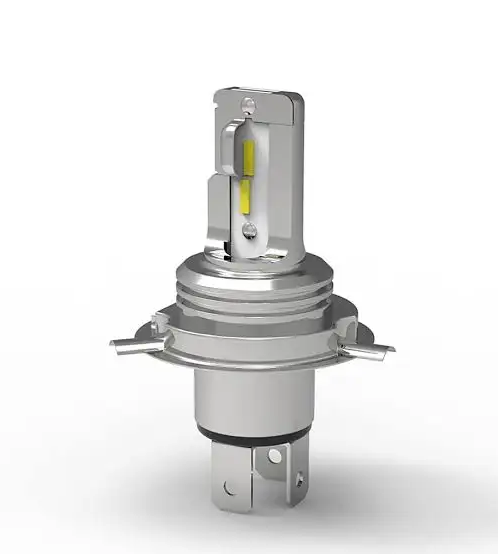
Oferim una gamma d'opcions personalitzables per als nostres bombetes LED, incloent diferents patrons de feix, temperatures de color i mides. Aquesta flexibilitat permet als clients adaptar la seva configuració d'il·luminació a les seves preferències i requisits específics.

Feu un pas endavant cap al futur de l'il·luminació automotiva amb les innovadores bombetes LED de NEWBROWN. Les nostres bombetes estan dissenyades amb tecnologia actualitzada que proporciona un feix brillant i ben definit que millora la visibilitat i el temps de resposta necessari per a una conducció segura. Les bombetes LED automotives fabricades per nosaltres són petites de mida, per tant, es poden instal·lar fàcilment en qualsevol model de cotxe. Trieu les solucions d'il·luminació avançades de NEWBROWN per fer que la vostra experiència de conducció sigui segura i agradable en els anys vinents.

Segueix el camí de conducció ecològica amb la àmplia gamma de bombetes LED automotives de NEWBROWN. Les nostres bombetes consumeixen menys energia però ofereixen una millor il·luminació, cosa que les fa respectuoses amb el medi ambient i econòmiques al final. En triar les bombetes LED automotives de NEWBROWN, estàs invertint en un futur sostenible sense afectar el rendiment ni l'estètica. Canvia a LEDs i redueix la teva empremta de carboni mentre mantens una bona qualitat de llum per al teu cotxe.

Benvingut a una vida lliure de compres recurrents de bombetes gràcies a les duradores bombetes LED automotives de NEWBROWN. Aquestes bombetes estan fabricades amb materials resistents i mecanismes sofisticats de dispersió de calor que les fan capaces de sobreviure en qualsevol condició de carretera. A diferència de les llums convencionals que es trenquen fàcilment o perden la seva brillantor amb el temps, aquest tipus roman brillant i funcional per sempre. Compreu il·luminació que perduri; que els vostres fars mai us fallin de nou, sigui quina sigui la ruta que preneu!

Les bombetes LED automotrius premium NEWBROWN permeten als conductors veure més lluny i ser més distintius. Aquestes llums estan dissenyades per al conductor actual, brillen més que qualsevol altra bombeta del mercat i això és important ja que garanteix la seguretat d'un conductor mentre està a la carretera, fins i tot quan és fosc com l'atzar. Aquestes bombetes també duren molt més que les halògenes normals, fent-les així més eficients en termes de consum d'energia i també fiables amb el temps, cosa que és crucial durant viatges llargs o un ús freqüent com el transport de mercaderies. Substitueix el teu antic sistema d'il·luminació avui mateix i obtén una millor visibilitat davant teu mentre condueixes de nit o travesses àrees boiroses.

Changzhou Zhanchen Brown Auto Spare Parts Co., Ltd, establert el 2013, és un fabricant i venedor important, especialitzat en il·luminació per vehicles, parts d'automòbil personalitzables, bombilles halèniques per vehicles i faros LED per vehicles. La nostra fàbrica es compromet a produir productes de alta qualitat i aquests són ben acceptats en els mercats globals, incloent-hi Estats Units, Alemanya, Itàlia, Espanya, Polònia, Romania, Canadà, Rússia, Austràlia, Regne Unit, entre d'altres. Avui en dia, algunes de les nostres parts d'automòbil i bombilles halèniques compleixen amb els estàndards de qualitat més rigorsos, amb certificacions que inclouen E-mark, ROHS, DOT, CE i ISO-9001. A més, servim com a proveïdor OEM i ODM per a marques reconegudes en l'indústria.
Experimenta una visibilitat superior amb els filtres halògens NEWBROWN per vehicles. Els nostres filtres estan dissenyats per emitir una llum blanca brillant que imita molt de pres la llum del dia natural, millorant la claritat i reduint l'esforç visual durant la conducció de nit. Amb una vida útil més llarga en comparació amb els filtres estàndard, els filtres halògens NEWBROWN ofereixen una il·luminació fiable per períodes extesos. Confia en NEWBROWN per il·luminar el teu viatge amb precisió i seguretat.
Conduï amb confiança amb els filtres NEWBROWN per vehicles. Els nostres filtres estan dissenyats per resistir condicions meteorològiques adverses, assegurant un rendiment consistent en pluja, neu o boira. La tecnologia avançada de la lentilla dispersa la llum uniformement, eliminant les zones d'ombra i oferint una vista clara de la carretera davant. Els filtres NEWBROWN són la combinació perfecta d'eficàcia i estil, fent-los una actualització essencial per a qualsevol vehicle.
Dillueu al futur de l'il·luminació automotiva amb els bulbs LED NEWBROWN. Aquests bulbs eficients en l'ús d'energia consumeixen menys potència mentre ofereixen un raig de llum potent. El disseny compacte permet una instal·lació fàcil, i la superfície fresca al tacte assegura la seguretat. Els bulbs LED NEWBROWN són no només ecològics sinó que també donen un tocat modern a l'il·luminació interior i exterior del vostre vehicle.
Il·lumineu el vostre conductorat amb una brillantor sense rivalitzar utilitzant els bulbs xenon NEWBROWN. Aquests bulbs produeixen una llum d'alta intensitat que millora significativament la visibilitat, especialment en condicions de poca llum. La tecnologia de gas xenon assegura un bulb més durador amb una llum més blanca i intensa. Els bulbs xenon NEWBROWN són l'elecció definitiva per als conductors que demanen el millor en il·luminació automotiva.
Oferim una varietat d'opcions de personalització per als nostres kits de carrosseria per a automòbils, com ara la selecció de materials, la combinació de colors i les modificacions del disseny. El nostre equip treballa estretament amb vostè per garantir que el producte final compleixi els seus requisits únics.
Sí, els nostres kits de carroceria d'automòbils estan dissenyats per ser compatibles amb una àmplia gamma de models de vehicles. Oferim kits de carroceria universals i específics per a models per satisfer les diverses necessitats dels nostres clients.
Recomanem que consultis amb el nostre equip de vendes experimentat per determinar la millor bombeta LED d'automòbil per al teu vehicle. Factors com el tipus de bombeta, la brillantor i la compatibilitat amb el sistema elèctric del vostre vehicle influiran en l'elecció.
